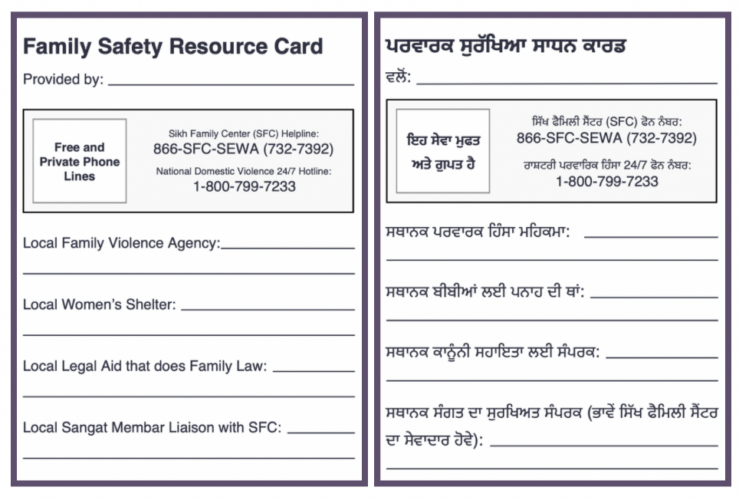Part of the Solution: A Family Violence Resource Guide for Gurdwaras
by Harmit Kaur
Growing up, I always believed that gurdwaras were a place to find solace or belonging in a sangat; they were built to serve the spiritual and social needs of a community. As a very young Kaur, going to the gurdwara meant eating fresh parshad, listening to kirtan, meeting relatives, doing seva. Over the years, I watched our local gurdwara transform, from what I believed was the perfect space to find solace and sangat, to a multi-million-dollar “dream” project. It is now one of the largest gurdwaras in North America; even a tourist destination.
Gurdwaras have adapted to evolving sangat realities and needs in so many ways: for example, incorporating English translations by installing projectors in divan halls, or inviting multilingual raagis to do kathaa/kirtans/shabads, or switching from Styrofoam to Earth-friendly plates and utensils. But sadly, one glaring thing they have not been able to adopt to consistently, is gender equality and supporting women.
Take this story, for instance.
In high school, I found myself doing various kinds of seva at gurdwaras. A friend asked for my support in collecting donations for a health project. I remember my interaction with a Bhai Sahib whom I asked for help arranging a table. He impatiently asked me what it was for, said he would be back, but never returned. Determined to stick to my plan and to make the most of my Sunday, I approached a Bibi Ji who in turn knew one of the Bhai Sahibs, just to get permission for a table set up. Bibi Ji became my ally; someone reassuring and supportive, who believed my time and energy was worth hers. Bibi Ji and I planned around how I would be returning for the next few Sundays, and how I could ensure bypassing the Bhai Sahib who decided to be uncooperative.
The interaction with this Bhai Sahib had reminded me how some kinds of work, by some kinds of people (women and girls) is particularly minimized and even dismissed. I had been made to feel what I was doing was not important; it made me feel uneasy, and disrespected. These feelings stayed with me for a very long time. Each time I had to approach a new gurdwara/committee member, I had to mentally prepare myself, to steel myself to deal with the risk of rejection. After so many times, and so many interactions, I am sure of one thing: each experience is different and we cannot wait for each and every gurdwara to welcome us in. We must keep making the asks; our gurdwaras are our shared spaces.
Who is Talking about Family Violence? Who is Walking the Talk?
Fast forward to today. I work for the Sikh Family Center, a community nonprofit that prioritizes health and well being, with a focus on gender justice. I regularly work to engage, interact with, and coordinate volunteers to interact with gurdwara committees and sevadaars. A notion my younger self would have laughed at, considering my trepidation around such tasks.
My journey into the gender justice and anti-violence field began in the “mainstream” community, but soon enough I could not ignore the prevalence of these issues in my own community, and the lack of services by and for Sikhs.
Our sangat, just as many others, comes with it’s own unique complexities and nuances. We all know family violence has lasting effects for generations and across the kaum. There are despicable crimes happening all over the country in Sikh homes whether we notice them, or pretend like we don’t. The stories of survivors were not just stories — they were a part of someone’s life, their reality. They pushed me to do more, seek more, change more.
It wasn’t until 2012 that I became aware of Sikh Family Center, the only Sikh American organization focused on addressing gender-based violence in the community.
I was immediately drawn to the organization’s various initiatives: the first National Helpline for Sikhs, community needs assessments on “taboo” issues, and violence prevention workshops for Sikh teens. I remember one of my first volunteering experiences was handing out Sikh Family Center’s community needs assessment surveys. I had taken a survey myself at the same table, and was surprised to see this question:
‘Have you ever heard someone talk about domestic violence at a gurdwara?’
I had not. Why not? Today, I am proud to work with a team that is going beyond asking that question, and in fact facilitating gurdwara talks and taking action around such violence.
As Sikhs, we pride ourselves in being front and center to support someone in need and think the first place to go for help is the ‘Guru’s Dwar’ or gurdwara. As a volunteer, and later staff person at the Sikh Family Center, I have heard many Sikh survivors acknowledge the role of gurdware in their attempts at both physical and emotional safety. We have had gurdwara sevadaars assist women, reinforce their right to safety, and refer them directly to our Helpline. Unfortunately, there are other gurdwara sevadaars who dismiss women and girls, even in the face of grave danger. There are those who insist they know what is best for the woman and will even coerce her into a “compromise” with her partner or in-laws. And then, there are those survivors who report that when they approached a seemingly well-meaning Bhai Sahib for help, he responded that he did not know what to do or know what resources to share. We hear this story too many times.
In this light, Sikh Family Center created, a resource for sevadars and gurdwaras. Sikh Family Center’s Family Violence Resource Guide is a tool for gurdwaras to employ in order to take simple and consistent steps that increase safety for victim-survivors of violence.
Take this “Family Safety Resource Card” for example.

Sikh Family Center can work with gurdwaras to create and share the Family Safety Resource Card to ensure that any person who discloses violence is given some information, resources or options, so that they may speak with a family violence expert.
I urge gurdwara leadership to invest in supporting this growing need of our community that has been overlooked far too long. By putting into action the simple steps outlined in the Guide, gurdwaras can take away the stigma of family violence and become better equipped to respond to survivors. Moreover, unlike large nagar kirtans, infrastructures, or even projectors for transliterations, implementing the steps outlined in the Gurdwara Guide will cost gurdware zero dollars!
Cultural Shift Requires Collective Action
Sikh Family Center has been working on the ground, insisting we acknowledge all our realities in our narratives about our communities, and empowering survivors by adopting community-specific solutions. As a community organizer, what keeps me inspired in this work, specifically, is the strength of individual survivors, and overall, witnessing a gradual cultural shift.
How you can be an ally and stand up against gender violence
As an ally, one can work alongside Sikh Family Center offering support in the following ways:
1. Support our “Take A Stand Against DV” campaign. It’s as simple as putting up flyers with SFC National Helpline number in community spaces, particularly in bathroom stalls so that someone in need can discreetly get access to resources and options.
2. Help us reach gurdwaras across the country by identifying a warm contact at a gurdwara. This contact might be a close friend, relative, Aunt, Uncle, Massi, Massar who is familiar with gurdwara leadership or committee member(s). With the help of your “warm contact,” we want the gurdwara committees to receive print copies of the Family Violence Resource Guide, and take simple next steps such as customizing the Guide’s Family Safety Resource Cards for their local sangat, and distributing them widely.
3. Encourage Singhs in your life (parents, siblings, friends, partners) to step up more! Singhs have a critical role in helping transform cultural and gender norms, breaking the cycles of violence. In fact, The Family Violence Resource Guide was written with active input from many gurdwara sevadaars (Singhs) who have been allies in Sikh Family Center’s work, and volunteered to share their experiences and recommendations on ways gurdwaras can increase safety for survivors of violence. Now, more Singhs can ensure others read and implement this Guide.
How to move from “Ally” to “Accomplice”
In the context of social justice, an accomplice can be anyone willing to take actions, small risks (e.g. to their social image, or to their preferred comfort zone), and use their power and privilege for change. While all accomplices are allies, not all allies are accomplices.
If like me, you are trying to overcome internalized fears of approaching our institutions, you are not alone. Let’s talk!
Here is one young Kaur, our amazing Gender Justice Intern, Tandeep Kaur, speaking about her experience in distributing and engaging with over 15 gurdware on the East Coast.
I believe the work we are calling everyone in to, the work with the gurdwaras, empowers others to take small risks and move towards an accomplice role.
As Kaurs we may often feel, as I once did, that no one will take us seriously. Stepping up in spaces that are predominantly male is an important way to advance the cultural change we need today.
Everyone can do something to begin working towards the goal of eradicating gender based violence. What are you willing to do?
About Harmit Kaur
Harmit Kaur has nearly a decade of professional experience working in the anti-violence movement providing supportive services to victim-survivors of domestic violence, sexual assault, and human trafficking. As Director of Programs with Sikh Family Center, Harmit has established best practices to meet community needs, and leads various program areas: crisis intervention, volunteer management, and community organizing. She has co authored evidence-based community reports, elevating the voices of Sikh American survivors of gendered violence by highlighting interventions, possible prevention, and identifying methods to strengthen diverse families. Harmit strives to change the way issues, such as gender based violence, and mental health are discussed and addressed in the community.
About The Sikh Family Center
Sikh Family Center promotes community health and well-being with a special focus on gender justice. We provide trauma-centered interventions for victim-survivors of violence while working to change the social and cultural conditions that allow gendered violence to occur in the first place. Our training, outreach, and advocacy are grounded in cultural tradition, grassroots power, and intergenerational healing.





2 Comments
kulvinder singh
10/05/2021 at 3:27 pmVery useful info and guides. The Bhai Sahibs may not know English well enough to interact with the Sikh youth. Don’t take them as the gatekeeper if you have an activity you believe will serve the community, as Bibi Ji was able to help Harmit here.
Rkaur
02/02/2022 at 8:39 pmGreat article writren by Harmit Kaur, eflecting the very core and inner values of our culture and, faith which takeover the underlying conflicts either by neglect or lack of awareness.